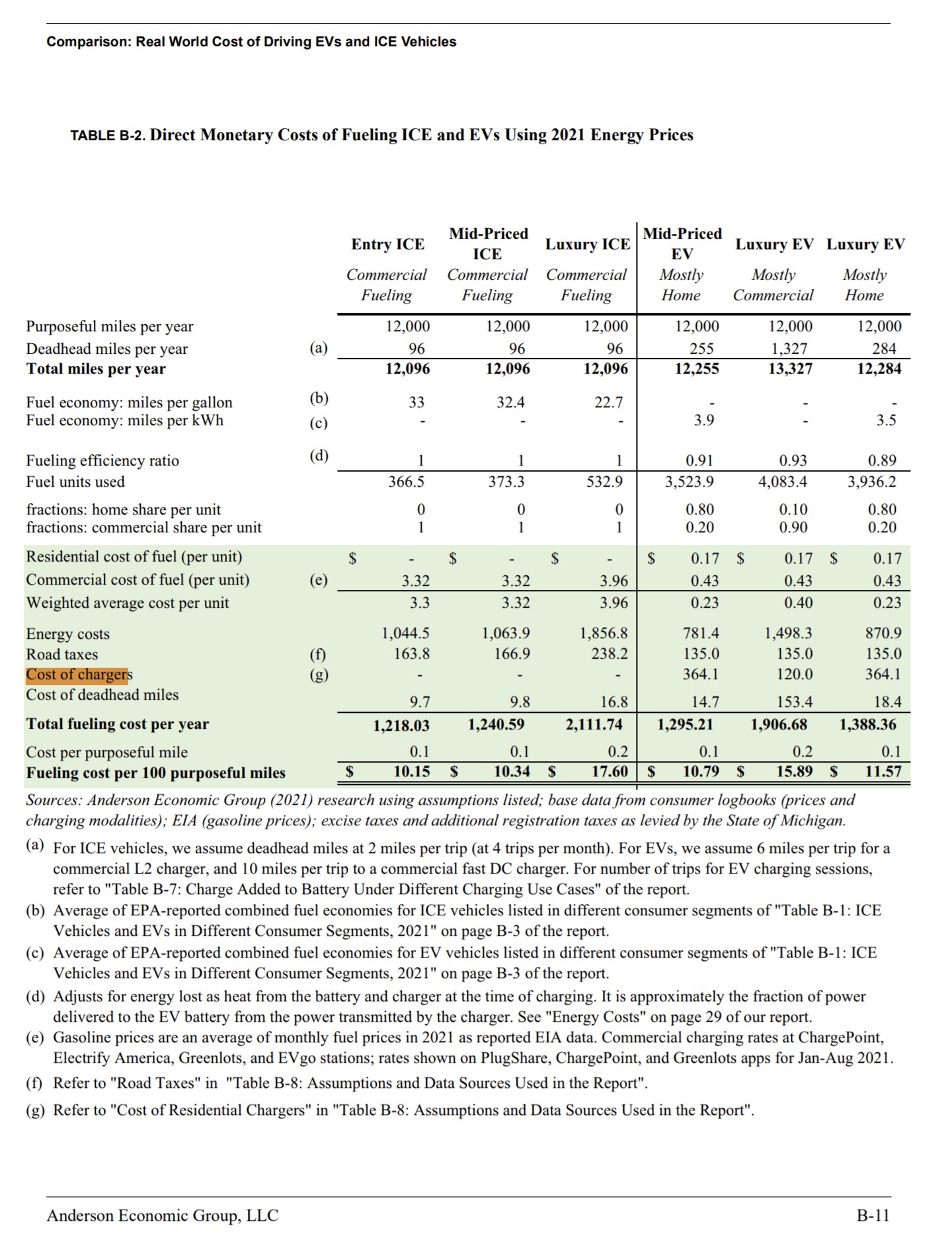Seems like bullshit to me. Recognizing the logical fallacy here, it’s still worth pointing out the firm has a history of working with major auto manufacturers, and is headquartered near Detroit. Their CEO, Patrick L. Anderson, also served under a Republican governor in multiple roles and is a contributor to numerous conservative research institutes.
Yeah, this is bullshit. I charge my car at home by leaving it plugged in overnight. Costs me literally a few bucks a month to keep it charged. I don’t even notice it on my electricity bill.
If I were charging at fee-based charging stations all the time, the story would be different, but who the hell does that?!?
We were looking at getting an EV without being able to charge it at home. Charging it at public chargers here in the UK would’ve cost about the same as petrol. But having to rely on the public charging infrastructure in its current state made us decide against it, at least for now.
Out of curiosity, why couldn’t you charge it at home? Most electric cars can have their chargers plugged into a standard wall outlet. It’s slower, but it works fine.
Same as what others said. We basically don’t have a driveway. The UK government is pushing for public chargers to become more reliable and easier to use though. This reinforced our fears that the current infrastructure may be unreliable but at the same time really gives hope that it will be good enough for us in the very near future. Our employer’s office also doesn’t currently offer charging, which some of our friends get, which is really nice for people in my situation.
A bit difficult to do if where your living you aren’t able to run the charging cable from the inside of your house to the outside.
Ah. Yeah, if you don’t have any external outlets, that would make an electric car less practical.
I made a similar decision. The only garages available to me are unpowered, not cheap, and not even super close to my apartment door. If I felt I could get my landlord to build the infrastructure for parking lot charging and penalize ice vehicles for parking in charging spaces I probably would’ve gone electric
This is such a major issue. I genuinely wonder if we apartment and non-garage having individuals are going to be just shit out of luck for a long time. People normally don’t care about us at all.
Yeah I figure that’ll be the case. Like I mentioned it to my gentrification happy landlord and apparently they’d never even considered it
If you are plugging into an outlet in your garage (level 1) you are only charging up 3 - 5 miles per hour. Putting in a 240v 40 amp (level 2) will get you 20 - 25 miles per hour i.e. a complete recharge for current batteries in 12 hours.
People who live in apartments and basement suites, basically anywhere with no garage. After 2030 or 2035 or whatever the deadline is there will be lots of people who have electric cars and no way to charge them overnight at home, so people will have to charge at public chargers everytime.
People who live in apartments. Or generally places where they can’t just plug in at home.
It seems inconsistent with other studies and the article only states results, not assumptions. Most importantly: where?
It’s not a
logical fallacyconspiracy when they’re really out to get you though.That said, my experience charging an EV in the space of one month cost as much as 14 twelve gallon tanks of gas. There may be something wrong with my electric service but the power company is an evil monopoly that doesn’t care about anything but getting paid so…
Assuming gas is $3.75/gal where you live, that is $630. If you spent $630 on charging your car in one month then you either drive 3000 miles a month or have a problem with your electric meter. Assuming you live in the state with the highest electricity prices that isn’t Hawaii (because then we couldn’t assume $3.75/gal for your gas), your rate is $0.34/kWh. That means you 1853kWh.
Assuming you drive the least efficient EV, the Hummer, which goes 329 miles on 213kWh, you would have to drive 2862 miles in one month to spend $630. So for the worst case electrical price, with the worst case EV mileage, with average gas prices, you are driving a lot more than most people to spend 14 twelve gallon tanks of gas worth. For reference, switching that Hummer to a Bolt would only cost $278 to drive 2862 miles.
It’s worse than that, it’s a hybrid that can only go maybe 30 miles before the battery is drained. So that doesn’t even account for 1000 miles. Super wasteful, but whatever’s going on isn’t the norm so I’m getting hit on multiple fronts.
There’s definitely a lot of nuance involved. For instance my service provider charges more for electricity than the public charge stations do (seriously fuck PG&E and every other monopolistic service provider), so I actually save money by not charging at home. It’s still absolutely cheaper than filling up on gas though, especially when I can find a spot where I don’t have to pay (like my work.)
Did you charge at home during the night, or during peak hours/at fast chargers?
How many tanks of gas would you have gone through in a comparable vehicle?
Only ever overnight, and maybe 5 tanks tops.
I don’t see how working with major manufacturers or being near Detroit makes it likely that this group wants to push an ICE narrative. Ford and GM have some of the most advanced electric vehicle systems in the world and are shipping more EV units than competitors.
The whole article and the report, nowhere is it explained how they get their numbers. What fuel prices or electricity prices have they used, what mileage for the cars. It’s kind of crucial info, and not really difficult to calculate either.
Yeah because the article is absolute bullshit. The bias was immediately evident.
Then why’d you post it? 😅
Because I saw the article on my newsfeed and clicked to see what it was about. I risked the impression I editorialized the headline by adding the “Research firm claims” but thought it might help readers here make up their own mind.
I think it’s good to read and criticise the materials that “opponents” read.
The report gives a quick summary of what they include, but not any details or math.
The cost of underlying energy (gas, diesel, electric)
State excise taxes charged for road maintenance
The cost to operate a pump or charger
The cost to drive to a fueling station (deadhead miles)Elsewhere it says it assumes 12k miles in a year and is focused on the midwest and Michigan in particular. As it so happens, Michigan charges for registration based on the car value. EVs cost more than ICE vehicles in the same market segment most of the time. This would fall under excise taxes that they include.
I wouldn’t be surprised if they also tacked on the cost to install a L2 charger once as “cost to operate a pump or charger” — intentionally ignoring that it’s a one-time fee to support EVs at a home. With those two data points they could easily add >$1000 to the cost to “charge” an EV for one year if that is what they wanted to do.
The people making the report clearly picked criteria that sounds reasonable but also intentionally misleads people. Not a surprise.
I could give an easy estimate for the costs with napkin math. A quick gooble search says that a long-range EV might require up to 100 kWh of power to charge (high estimate) and where I live the electricity cost is about $0.11/kWh. That’s $11 for a “fill up” of a long-range EV.
A tank of gas that could get me 300 miles is closer to $40.
$11 < $40.
Research firm is bullshitting. It costs like $1-$2 for me to fill up my car with electricity at home.
Where i live its literally 5 times cheaper. I call bullshit.
This is pretty similar to the numbers I ran myself. Public charging costs about the same as gas, and home electricity (particularly if in a cheap area) is where the savings come from. This was using US numbers, which has some of the cheapest gas in the world.
Well this article just isn’t right at all
I drive an entry level EV (Hyundai Kona) that advertises 4mi/kWh, which is roughly accurate (2-3 in the winter, 5-7 in the summer). That’s 25 kWh for 100 miles.
Average cost of electricity in the US is, according to a quick Google, somewhere between $.15 and $.25 per kWh; where I live it’s a steeper $.33.
Therefore, depending on where I charge, I’m paying anywhere between $3.75 and $8.25 to drive 100 miles–$1.50 short of the article’s published $9.78 even with my expensive power.
In reality, though, I pay nothing–my office offers free charging. Show me an office with free gas.
Does not include the cost of environmental impact of burning fossil fuels… Which we are all starting to pay.
From August 2022 to August 2023 I’ve spent $220 dollars TOTAL on keeping my EV charged…
I’m not reading further down the line to see but did anyone notice the pic used in this post to show someone not understanding where their fuel door is? Back out and back in correctly and pump gas like a normal human being.
That’s a Costco, they specificially tell you to use any lane and the hose is long enough to reach. That person is just following directions. The stations are built with one way traffic flow and get very busy, it’s not practical to queue for a particular side of the car.
Ah! Today I learned that happens. Thanks for letting me know.
MOST cars have the fuel door on the left, Costco tends to have more cars queue in the lanes that match up with the left hand fuel door so regardless of what side your fuel door is on grab the lanes with the pump on the right of your car and you’ll get through a bit faster since you can pull it around.
Cost to fill up is not cost of ownership.
Given that oil changes don’t cost that much, electric cars almost universally cost significantly more than the same ICE car, and insurance rates are tied heavily to the value of the car, ICE/Hybrids still have a pretty good advantage on non-fillup costs. If/When electric cars cost the same as an ICE car to buy, that math with change considerably.
Yes, of course, oil changes are the only additional cost of an ICE engine /s
This is absolutely stupid. The only way you’re spending more on EV charging is if you get the most expensive at-home charger with the most expensive professional installation, and then never use it because you only charge at the most expensive level-3 chargers. I almost exclusively charge my Bolt for free, but even when I pay for the electricity it’s the cost equivalent of getting 120-150 mpg. The level-3 chargers like Electrify America come out to be in the same ballpark as gas in terms of cost per mile, maybe even a little more… But you’d have to use them to ridiculous excess for the overall cost of driving to even approach ICE vehicles.
This sounds like BS. Years ago I calculated the cost of electricity is 1/5 of gas. Unless electricity jacked up (gas has stayed roughly the same) this doesn’t make sense.
…how? Like, it cost $30 (10 gal) to fill my petrol car in the states. Even if I was using 150kwh in electricity, at my power rate in Wisconsin ($.13/kWh), it’s $19.95. I live in Vietnam now, and pay 2500 VND per kWh, and petrol is about 23500vnd/litre. I have an electric moped that goes 110km/charge, and has a usable capacity of about 0.7kwh. I rarely empty the battery, but even if I did it daily, it would be .08USD/day.
I’d like to see the math crunched on this.
Edit: I found the math. It’s dishonest. Shocker.

What kind of maniac intentionally only charges at public charging stations? That would be the only way I could see to make filling up an EV cost more. Maybe on-street parking apartment dwellers who also can’t charge at work would fit that description.
I got blasted with a $700 electric bill this month, and we didn’t really do anything new or different. So this doesn’t surprise me really.
If electricity is going to cost this much, I guess the only way electric gets “cheaper” than gas is by hiking gas prices until its cheaper to charge. Consumers are never going to win though.
What was your bill the month before? How much more or less did you run the AC this month? Did you take any road trips?
You can make your own electricity at home if you have the room, by installing solar panels.
IMO everyone should invest in off-grid solar if you can manage it. I have electricity on tap no matter what the power company or their wires are doing.
Or if gas is actually cheaper than electricity, just install a trailer hitch and a hitch cargo carrier, then mount an inverter generator on your cargo carrier and charge the EV on the go with gas.
deleted by creator











